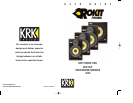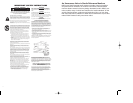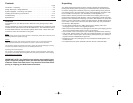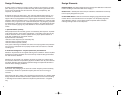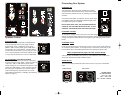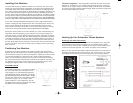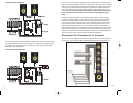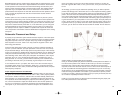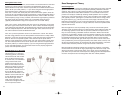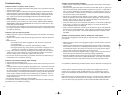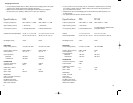
Design Philosophy
A studio monitor is really a tool used to aurally “measure” the changes in an audio
path. Ask any pro or semi-pro recordist what they think makes a great studio moni-
tor and you’ll get basically the same answers: “Accuracy, transparency, “flat
response”, and “the truth”.
Everybody is saying the same thing – they want the electrical signal going in to a
monitor to be reproduced mechanically by the transducers and they want that to
happen without any degradation to the original signal. Professionals need to trust a
speaker to deliver their artistic vision in a way that will translate to a variety of audio
mediums. How you get there from a technical stand point is by designing a speaker
that eliminates or minimizes several damaging conditions. The KRK design philoso-
phy is manifested by paying very close attention to what we call the three corner-
stones:
1. Spectral Balance (Timbre)
What people tend to think sounds good is not necessarily “flat response.” A perfect-
ly flat monitor tends to sound harsh and abrasive – technically correct but not very
musical. Research shows us that a speaker with the proper spectral balance is
most often considered “a great studio monitor”.
Spectral balance is defined by:
• Smooth on-axis response (not necessarily flat)
• Smooth octave to octave response
• Smooth off-axis response (not flat)
From years of listening to feedback from some of the top engineers and producers
we’ve come to understand how a properly tuned monitor can become a valuable
recording tool.
2. Distortion Management – Physical (Non-linear) and Electronic
Distortion: Any deviation of the original audio signal is a distortion. Various amplifier
distortions have been identified; the most commonly measured being intermodula-
tion and harmonic distortion.
Distortion can be present in an amplifier circuit but can really be a problem when
the acoustical waveform is impacted by physical conditions such as port turbulence
and driver distortion. KRK engineers implement design concepts that eliminate or
minimize these damaging conditions.
3. Resonance Management
Resonance: The prolonging of the sound at a certain frequency and the tendency
of something to vibrate at a particular frequency after the source of energy is
removed.
Resonances also play a major role in impacting the performance of a speaker. KRK
design elements minimize cabinet vibration, speaker frames and cones resonating
or standing waves inside the cabinet that impact the performance in a negative
way.
Design Elements
Radiuses Edges - All cabinet edges and port openings are Radiuses to reduce dif-
fraction resulting in better detail and stereo imaging.
Slotted Ports – Slotted ports reduce the port turbulence and distortion commonly
found in poorly designed round ports.
Custom Made Drivers - KRK is renowned for designing high performance studio
monitor drivers. Your Rokit Powered is no exception. Our Proprietary Signature
Yellow Woofers made of a woven glass aramid composite deliver articulate
midrange and tight clear low end response.
3
4



